Artificial Intelligence in Biomedicine: Context, and Analysis
VerifiedAdded on 2022/09/18
|16
|4463
|17
Report
AI Summary
This report provides a comprehensive overview of the application of Artificial Intelligence (AI) in biomedicine. It begins with an executive summary and an introduction that defines AI in the context of biomedicine, highlighting its use of algorithms to analyze complex medical data and its aim to improve healthcare outcomes. The report delves into the background and context of AI in biomedicine, discussing the specific concerns addressed by AI, its importance, and existing knowledge gaps. A literature review analyzes various academic pieces, demonstrating real-world cases where AI is utilized, such as in cardiology, neurology, and cancer diagnosis. The report also includes a discussion and critical analysis of AI's limitations, ethical considerations, and potential impact on the workforce, concluding with a summary of the key findings.
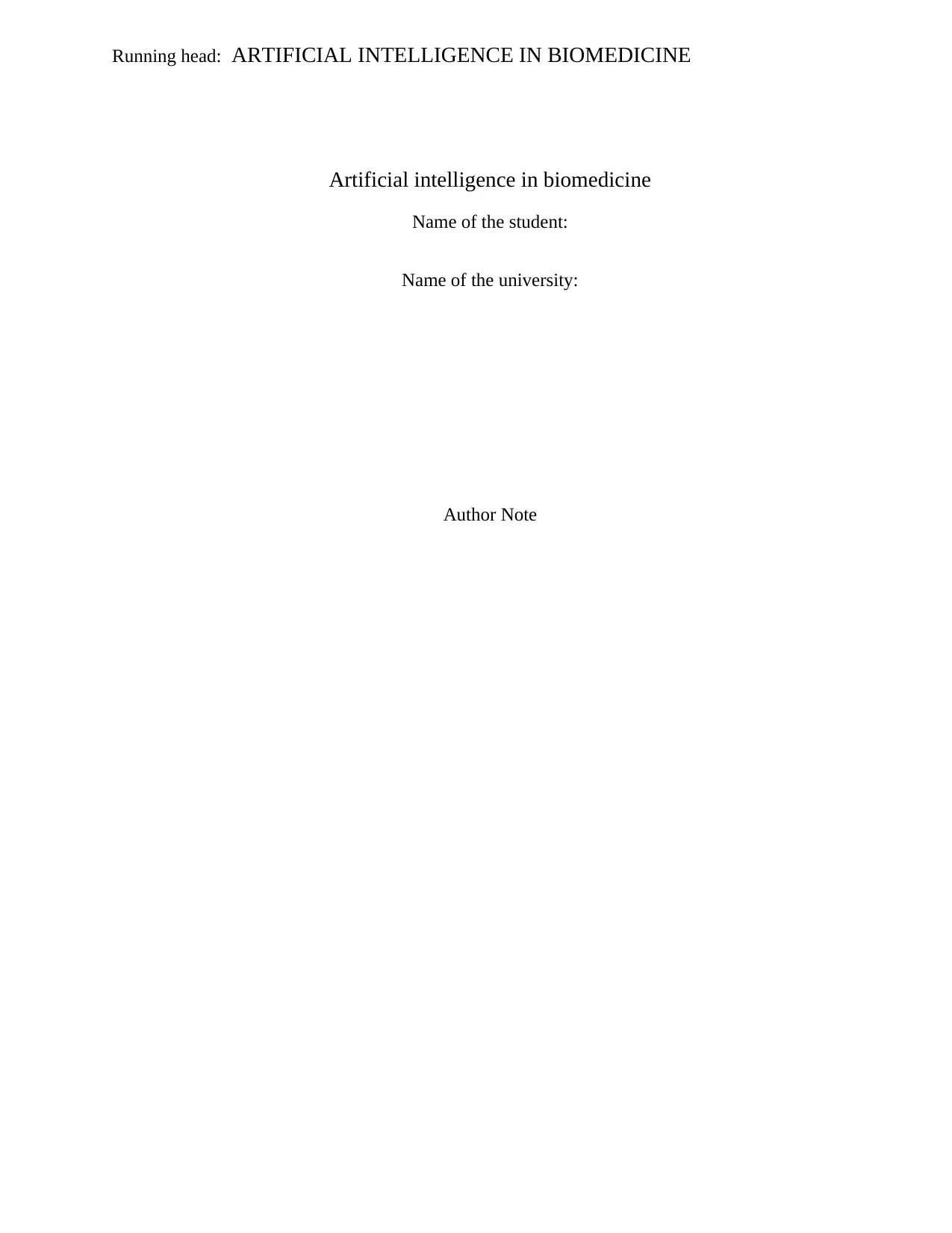
Running head: ARTIFICIAL INTELLIGENCE IN BIOMEDICINE
Artificial intelligence in biomedicine
Name of the student:
Name of the university:
Author Note
Artificial intelligence in biomedicine
Name of the student:
Name of the university:
Author Note
Paraphrase This Document
Need a fresh take? Get an instant paraphrase of this document with our AI Paraphraser
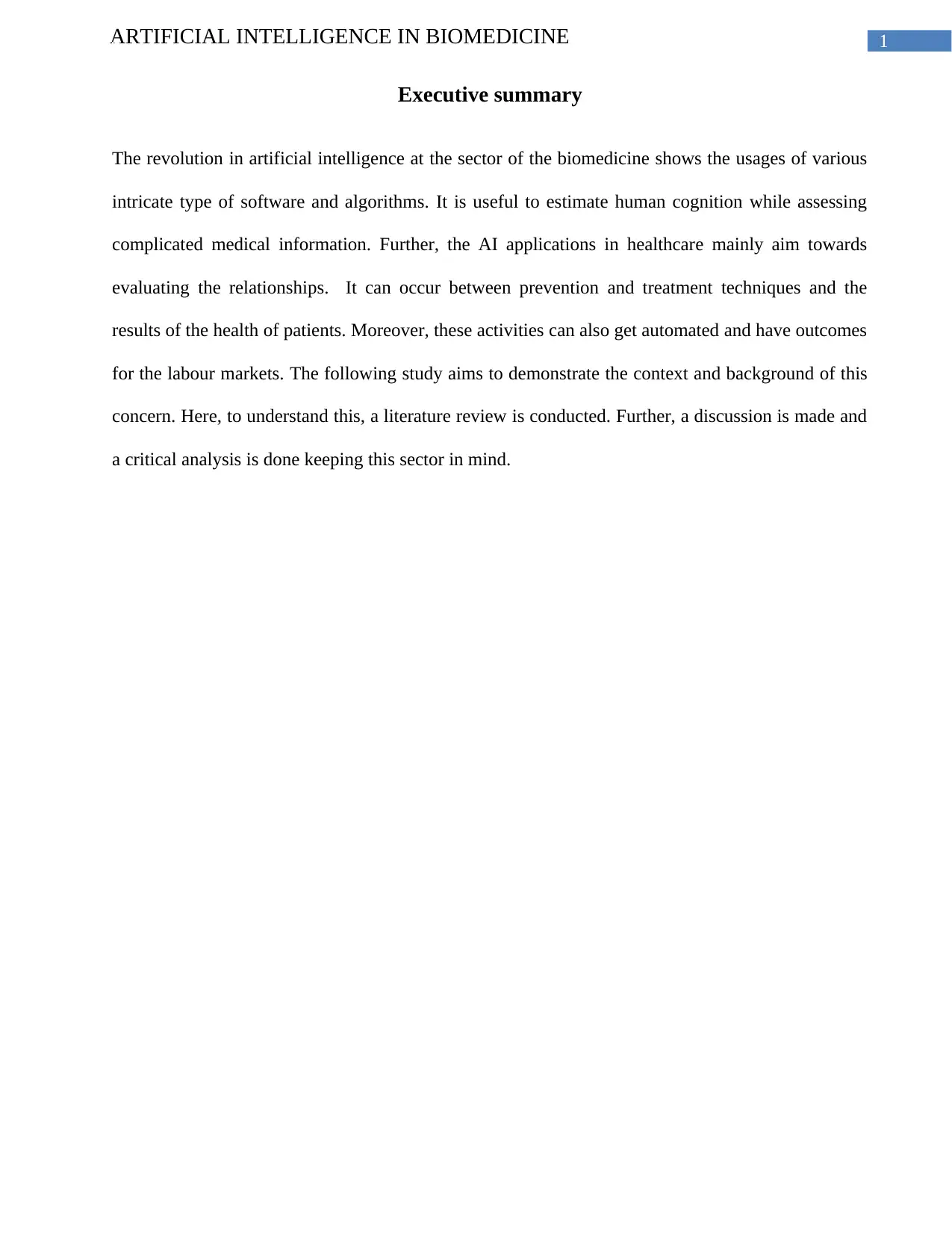
1ARTIFICIAL INTELLIGENCE IN BIOMEDICINE
Executive summary
The revolution in artificial intelligence at the sector of the biomedicine shows the usages of various
intricate type of software and algorithms. It is useful to estimate human cognition while assessing
complicated medical information. Further, the AI applications in healthcare mainly aim towards
evaluating the relationships. It can occur between prevention and treatment techniques and the
results of the health of patients. Moreover, these activities can also get automated and have outcomes
for the labour markets. The following study aims to demonstrate the context and background of this
concern. Here, to understand this, a literature review is conducted. Further, a discussion is made and
a critical analysis is done keeping this sector in mind.
Executive summary
The revolution in artificial intelligence at the sector of the biomedicine shows the usages of various
intricate type of software and algorithms. It is useful to estimate human cognition while assessing
complicated medical information. Further, the AI applications in healthcare mainly aim towards
evaluating the relationships. It can occur between prevention and treatment techniques and the
results of the health of patients. Moreover, these activities can also get automated and have outcomes
for the labour markets. The following study aims to demonstrate the context and background of this
concern. Here, to understand this, a literature review is conducted. Further, a discussion is made and
a critical analysis is done keeping this sector in mind.
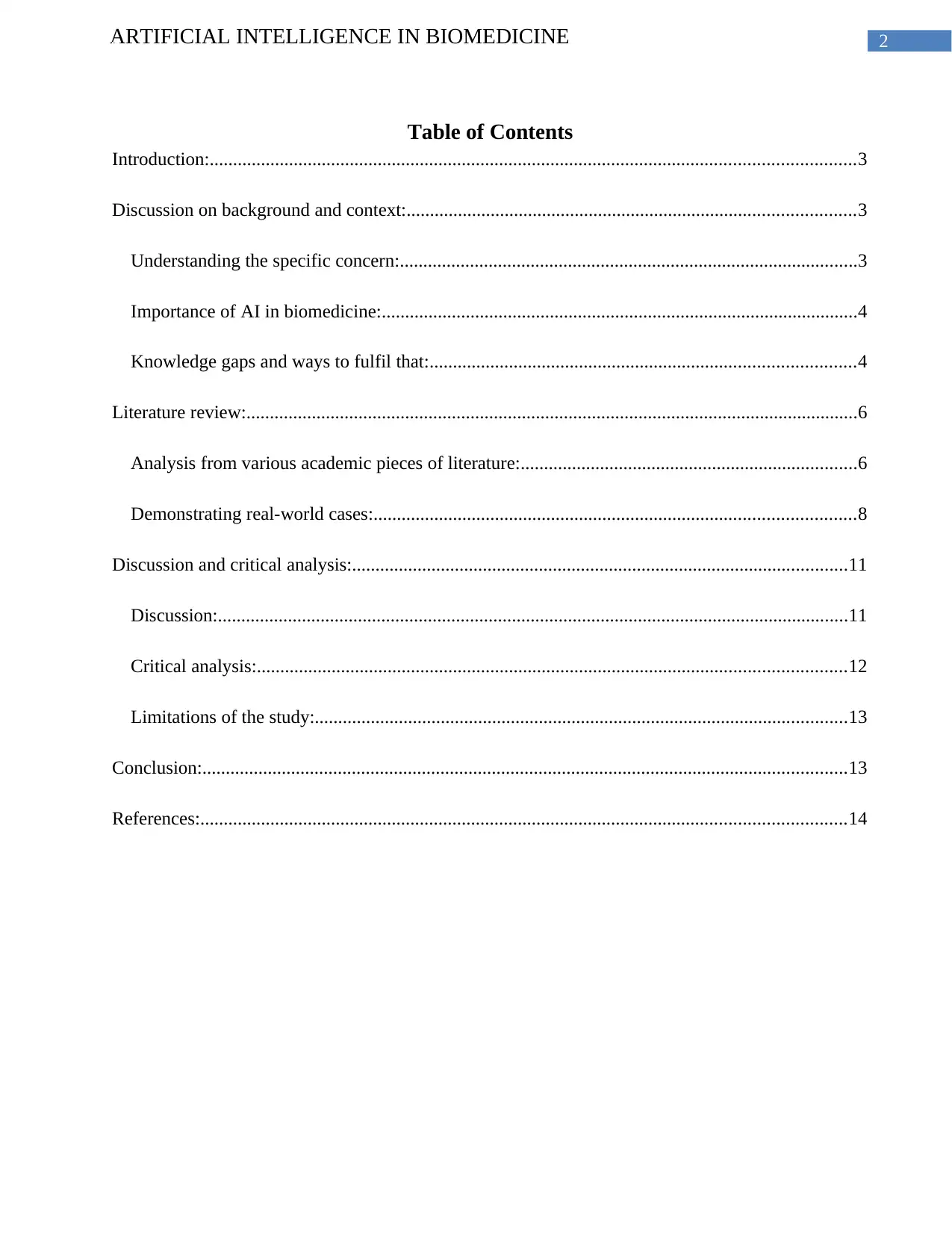
2ARTIFICIAL INTELLIGENCE IN BIOMEDICINE
Table of Contents
Introduction:..........................................................................................................................................3
Discussion on background and context:................................................................................................3
Understanding the specific concern:..................................................................................................3
Importance of AI in biomedicine:......................................................................................................4
Knowledge gaps and ways to fulfil that:...........................................................................................4
Literature review:...................................................................................................................................6
Analysis from various academic pieces of literature:........................................................................6
Demonstrating real-world cases:.......................................................................................................8
Discussion and critical analysis:..........................................................................................................11
Discussion:.......................................................................................................................................11
Critical analysis:..............................................................................................................................12
Limitations of the study:..................................................................................................................13
Conclusion:..........................................................................................................................................13
References:..........................................................................................................................................14
Table of Contents
Introduction:..........................................................................................................................................3
Discussion on background and context:................................................................................................3
Understanding the specific concern:..................................................................................................3
Importance of AI in biomedicine:......................................................................................................4
Knowledge gaps and ways to fulfil that:...........................................................................................4
Literature review:...................................................................................................................................6
Analysis from various academic pieces of literature:........................................................................6
Demonstrating real-world cases:.......................................................................................................8
Discussion and critical analysis:..........................................................................................................11
Discussion:.......................................................................................................................................11
Critical analysis:..............................................................................................................................12
Limitations of the study:..................................................................................................................13
Conclusion:..........................................................................................................................................13
References:..........................................................................................................................................14
⊘ This is a preview!⊘
Do you want full access?
Subscribe today to unlock all pages.

Trusted by 1+ million students worldwide
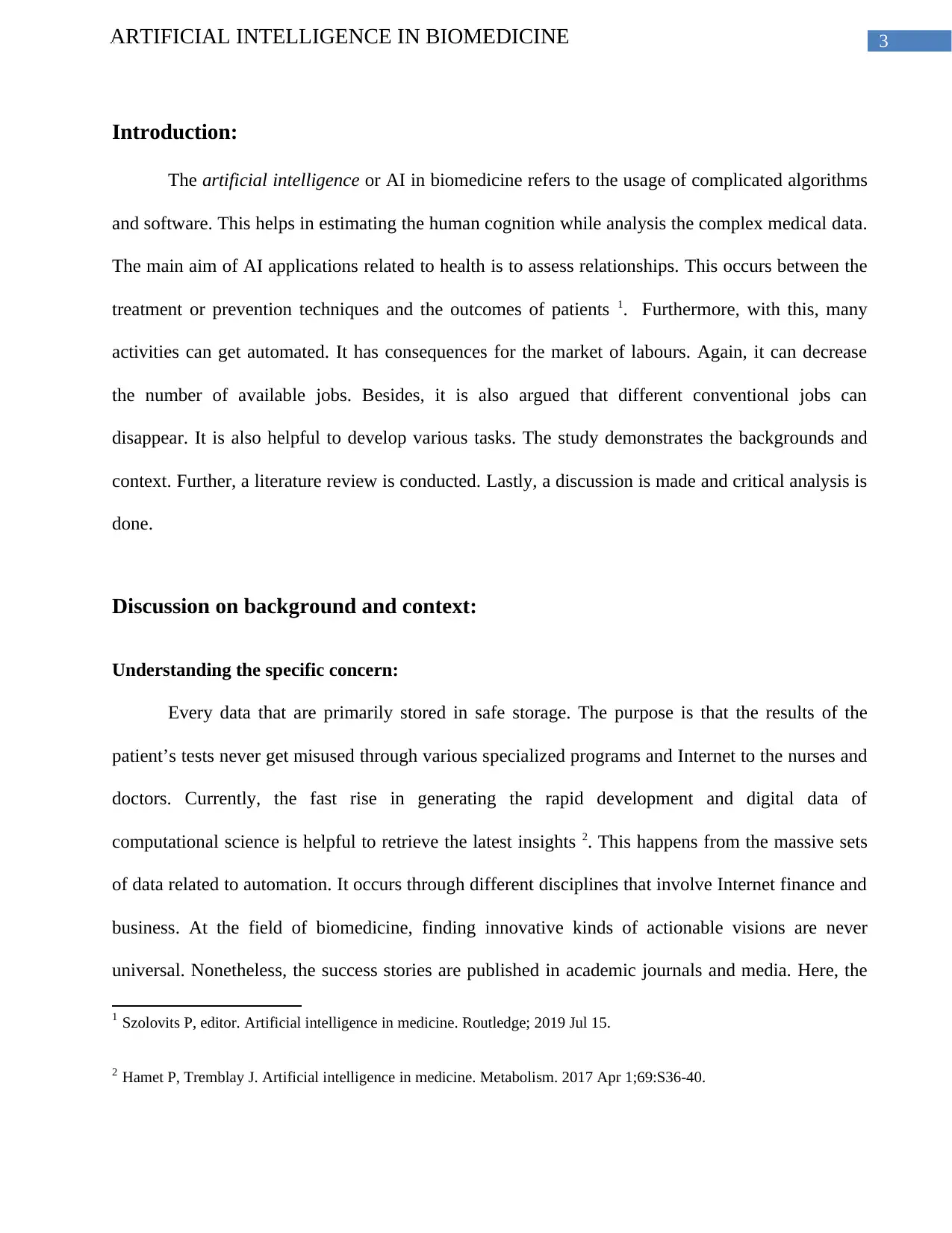
3ARTIFICIAL INTELLIGENCE IN BIOMEDICINE
Introduction:
The artificial intelligence or AI in biomedicine refers to the usage of complicated algorithms
and software. This helps in estimating the human cognition while analysis the complex medical data.
The main aim of AI applications related to health is to assess relationships. This occurs between the
treatment or prevention techniques and the outcomes of patients 1. Furthermore, with this, many
activities can get automated. It has consequences for the market of labours. Again, it can decrease
the number of available jobs. Besides, it is also argued that different conventional jobs can
disappear. It is also helpful to develop various tasks. The study demonstrates the backgrounds and
context. Further, a literature review is conducted. Lastly, a discussion is made and critical analysis is
done.
Discussion on background and context:
Understanding the specific concern:
Every data that are primarily stored in safe storage. The purpose is that the results of the
patient’s tests never get misused through various specialized programs and Internet to the nurses and
doctors. Currently, the fast rise in generating the rapid development and digital data of
computational science is helpful to retrieve the latest insights 2. This happens from the massive sets
of data related to automation. It occurs through different disciplines that involve Internet finance and
business. At the field of biomedicine, finding innovative kinds of actionable visions are never
universal. Nonetheless, the success stories are published in academic journals and media. Here, the
1 Szolovits P, editor. Artificial intelligence in medicine. Routledge; 2019 Jul 15.
2 Hamet P, Tremblay J. Artificial intelligence in medicine. Metabolism. 2017 Apr 1;69:S36-40.
Introduction:
The artificial intelligence or AI in biomedicine refers to the usage of complicated algorithms
and software. This helps in estimating the human cognition while analysis the complex medical data.
The main aim of AI applications related to health is to assess relationships. This occurs between the
treatment or prevention techniques and the outcomes of patients 1. Furthermore, with this, many
activities can get automated. It has consequences for the market of labours. Again, it can decrease
the number of available jobs. Besides, it is also argued that different conventional jobs can
disappear. It is also helpful to develop various tasks. The study demonstrates the backgrounds and
context. Further, a literature review is conducted. Lastly, a discussion is made and critical analysis is
done.
Discussion on background and context:
Understanding the specific concern:
Every data that are primarily stored in safe storage. The purpose is that the results of the
patient’s tests never get misused through various specialized programs and Internet to the nurses and
doctors. Currently, the fast rise in generating the rapid development and digital data of
computational science is helpful to retrieve the latest insights 2. This happens from the massive sets
of data related to automation. It occurs through different disciplines that involve Internet finance and
business. At the field of biomedicine, finding innovative kinds of actionable visions are never
universal. Nonetheless, the success stories are published in academic journals and media. Here, the
1 Szolovits P, editor. Artificial intelligence in medicine. Routledge; 2019 Jul 15.
2 Hamet P, Tremblay J. Artificial intelligence in medicine. Metabolism. 2017 Apr 1;69:S36-40.
Paraphrase This Document
Need a fresh take? Get an instant paraphrase of this document with our AI Paraphraser
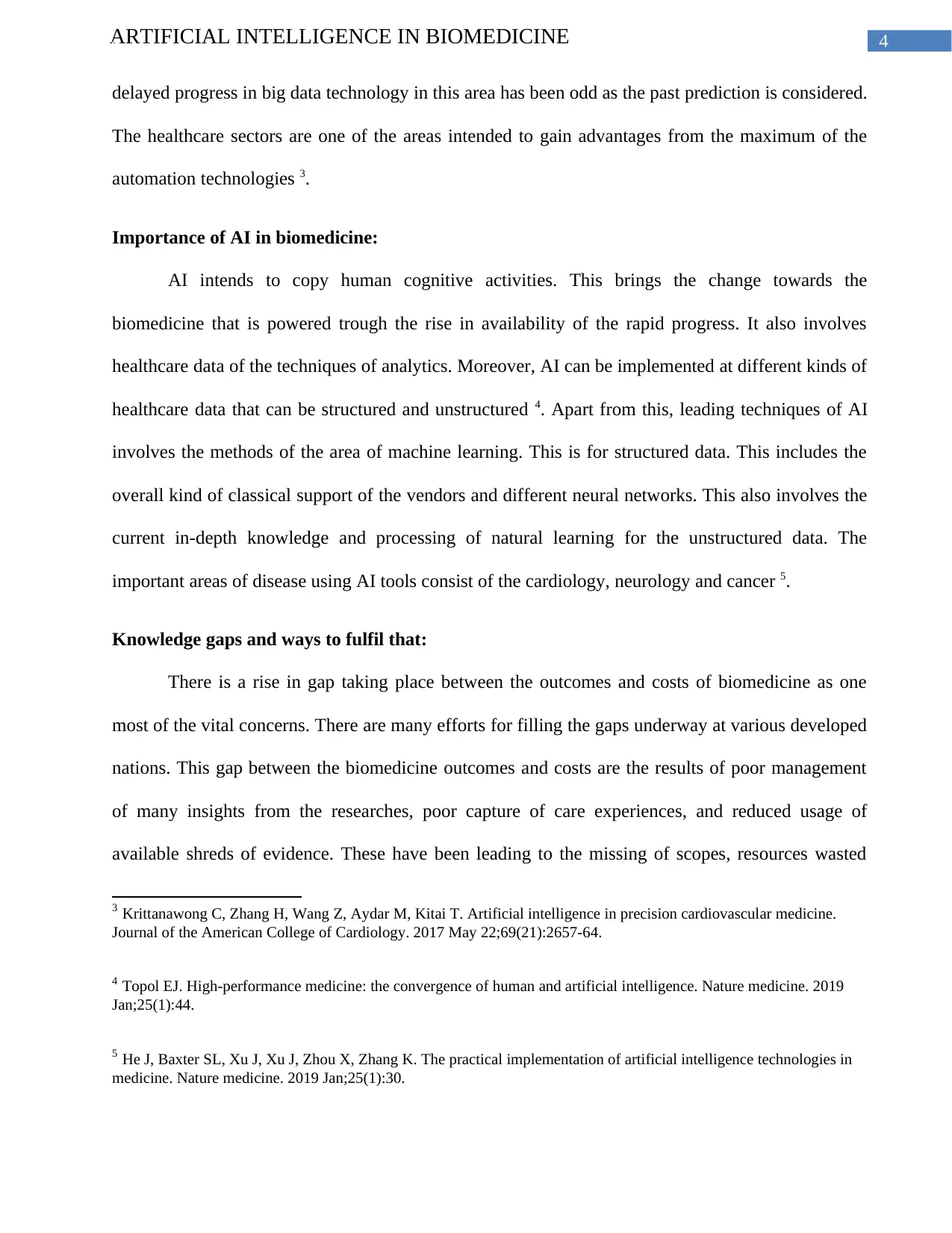
4ARTIFICIAL INTELLIGENCE IN BIOMEDICINE
delayed progress in big data technology in this area has been odd as the past prediction is considered.
The healthcare sectors are one of the areas intended to gain advantages from the maximum of the
automation technologies 3.
Importance of AI in biomedicine:
AI intends to copy human cognitive activities. This brings the change towards the
biomedicine that is powered trough the rise in availability of the rapid progress. It also involves
healthcare data of the techniques of analytics. Moreover, AI can be implemented at different kinds of
healthcare data that can be structured and unstructured 4. Apart from this, leading techniques of AI
involves the methods of the area of machine learning. This is for structured data. This includes the
overall kind of classical support of the vendors and different neural networks. This also involves the
current in-depth knowledge and processing of natural learning for the unstructured data. The
important areas of disease using AI tools consist of the cardiology, neurology and cancer 5.
Knowledge gaps and ways to fulfil that:
There is a rise in gap taking place between the outcomes and costs of biomedicine as one
most of the vital concerns. There are many efforts for filling the gaps underway at various developed
nations. This gap between the biomedicine outcomes and costs are the results of poor management
of many insights from the researches, poor capture of care experiences, and reduced usage of
available shreds of evidence. These have been leading to the missing of scopes, resources wasted
3 Krittanawong C, Zhang H, Wang Z, Aydar M, Kitai T. Artificial intelligence in precision cardiovascular medicine.
Journal of the American College of Cardiology. 2017 May 22;69(21):2657-64.
4 Topol EJ. High-performance medicine: the convergence of human and artificial intelligence. Nature medicine. 2019
Jan;25(1):44.
5 He J, Baxter SL, Xu J, Xu J, Zhou X, Zhang K. The practical implementation of artificial intelligence technologies in
medicine. Nature medicine. 2019 Jan;25(1):30.
delayed progress in big data technology in this area has been odd as the past prediction is considered.
The healthcare sectors are one of the areas intended to gain advantages from the maximum of the
automation technologies 3.
Importance of AI in biomedicine:
AI intends to copy human cognitive activities. This brings the change towards the
biomedicine that is powered trough the rise in availability of the rapid progress. It also involves
healthcare data of the techniques of analytics. Moreover, AI can be implemented at different kinds of
healthcare data that can be structured and unstructured 4. Apart from this, leading techniques of AI
involves the methods of the area of machine learning. This is for structured data. This includes the
overall kind of classical support of the vendors and different neural networks. This also involves the
current in-depth knowledge and processing of natural learning for the unstructured data. The
important areas of disease using AI tools consist of the cardiology, neurology and cancer 5.
Knowledge gaps and ways to fulfil that:
There is a rise in gap taking place between the outcomes and costs of biomedicine as one
most of the vital concerns. There are many efforts for filling the gaps underway at various developed
nations. This gap between the biomedicine outcomes and costs are the results of poor management
of many insights from the researches, poor capture of care experiences, and reduced usage of
available shreds of evidence. These have been leading to the missing of scopes, resources wasted
3 Krittanawong C, Zhang H, Wang Z, Aydar M, Kitai T. Artificial intelligence in precision cardiovascular medicine.
Journal of the American College of Cardiology. 2017 May 22;69(21):2657-64.
4 Topol EJ. High-performance medicine: the convergence of human and artificial intelligence. Nature medicine. 2019
Jan;25(1):44.
5 He J, Baxter SL, Xu J, Xu J, Zhou X, Zhang K. The practical implementation of artificial intelligence technologies in
medicine. Nature medicine. 2019 Jan;25(1):30.
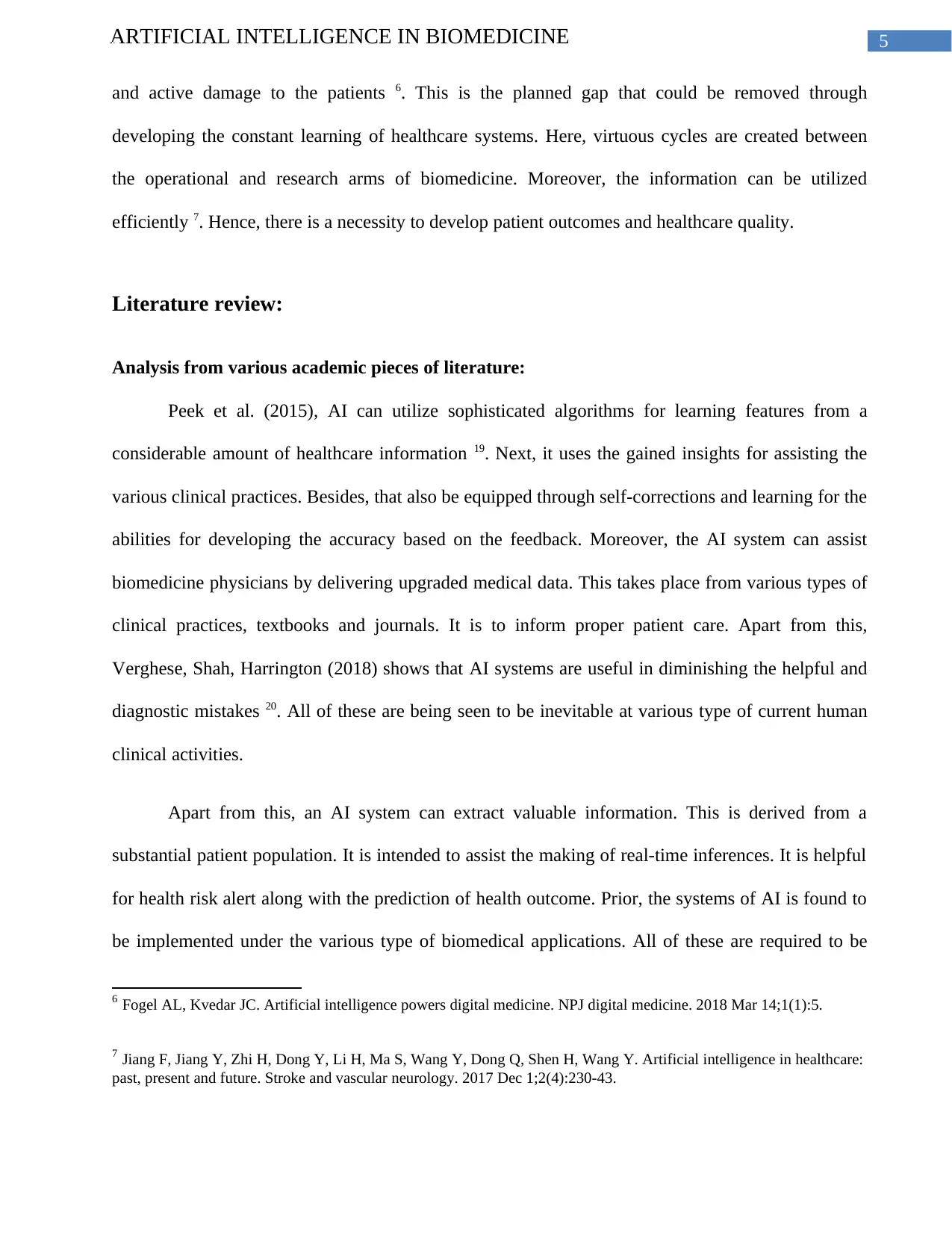
5ARTIFICIAL INTELLIGENCE IN BIOMEDICINE
and active damage to the patients 6. This is the planned gap that could be removed through
developing the constant learning of healthcare systems. Here, virtuous cycles are created between
the operational and research arms of biomedicine. Moreover, the information can be utilized
efficiently 7. Hence, there is a necessity to develop patient outcomes and healthcare quality.
Literature review:
Analysis from various academic pieces of literature:
Peek et al. (2015), AI can utilize sophisticated algorithms for learning features from a
considerable amount of healthcare information 19. Next, it uses the gained insights for assisting the
various clinical practices. Besides, that also be equipped through self-corrections and learning for the
abilities for developing the accuracy based on the feedback. Moreover, the AI system can assist
biomedicine physicians by delivering upgraded medical data. This takes place from various types of
clinical practices, textbooks and journals. It is to inform proper patient care. Apart from this,
Verghese, Shah, Harrington (2018) shows that AI systems are useful in diminishing the helpful and
diagnostic mistakes 20. All of these are being seen to be inevitable at various type of current human
clinical activities.
Apart from this, an AI system can extract valuable information. This is derived from a
substantial patient population. It is intended to assist the making of real-time inferences. It is helpful
for health risk alert along with the prediction of health outcome. Prior, the systems of AI is found to
be implemented under the various type of biomedical applications. All of these are required to be
6 Fogel AL, Kvedar JC. Artificial intelligence powers digital medicine. NPJ digital medicine. 2018 Mar 14;1(1):5.
7 Jiang F, Jiang Y, Zhi H, Dong Y, Li H, Ma S, Wang Y, Dong Q, Shen H, Wang Y. Artificial intelligence in healthcare:
past, present and future. Stroke and vascular neurology. 2017 Dec 1;2(4):230-43.
and active damage to the patients 6. This is the planned gap that could be removed through
developing the constant learning of healthcare systems. Here, virtuous cycles are created between
the operational and research arms of biomedicine. Moreover, the information can be utilized
efficiently 7. Hence, there is a necessity to develop patient outcomes and healthcare quality.
Literature review:
Analysis from various academic pieces of literature:
Peek et al. (2015), AI can utilize sophisticated algorithms for learning features from a
considerable amount of healthcare information 19. Next, it uses the gained insights for assisting the
various clinical practices. Besides, that also be equipped through self-corrections and learning for the
abilities for developing the accuracy based on the feedback. Moreover, the AI system can assist
biomedicine physicians by delivering upgraded medical data. This takes place from various types of
clinical practices, textbooks and journals. It is to inform proper patient care. Apart from this,
Verghese, Shah, Harrington (2018) shows that AI systems are useful in diminishing the helpful and
diagnostic mistakes 20. All of these are being seen to be inevitable at various type of current human
clinical activities.
Apart from this, an AI system can extract valuable information. This is derived from a
substantial patient population. It is intended to assist the making of real-time inferences. It is helpful
for health risk alert along with the prediction of health outcome. Prior, the systems of AI is found to
be implemented under the various type of biomedical applications. All of these are required to be
6 Fogel AL, Kvedar JC. Artificial intelligence powers digital medicine. NPJ digital medicine. 2018 Mar 14;1(1):5.
7 Jiang F, Jiang Y, Zhi H, Dong Y, Li H, Ma S, Wang Y, Dong Q, Shen H, Wang Y. Artificial intelligence in healthcare:
past, present and future. Stroke and vascular neurology. 2017 Dec 1;2(4):230-43.
⊘ This is a preview!⊘
Do you want full access?
Subscribe today to unlock all pages.

Trusted by 1+ million students worldwide
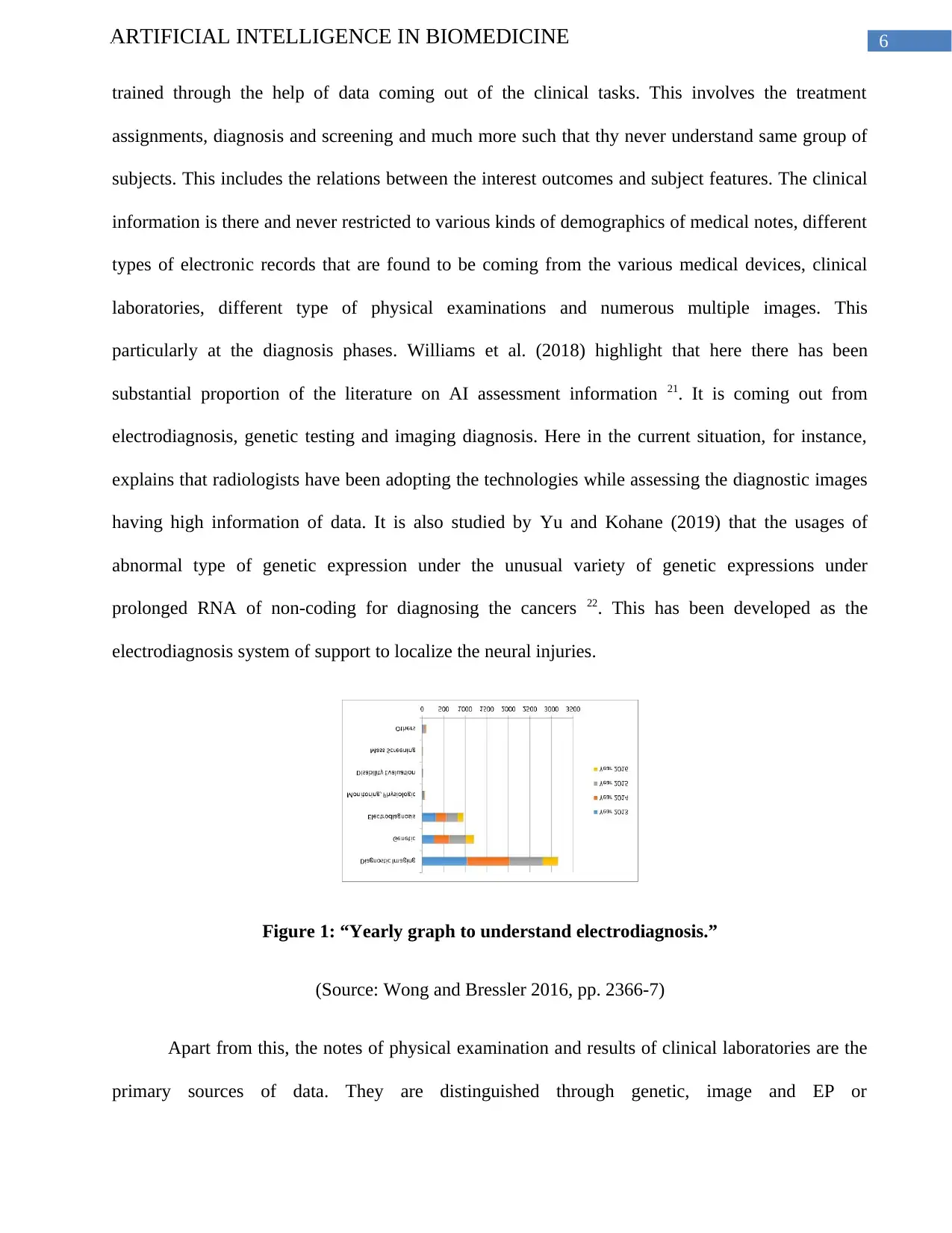
6ARTIFICIAL INTELLIGENCE IN BIOMEDICINE
trained through the help of data coming out of the clinical tasks. This involves the treatment
assignments, diagnosis and screening and much more such that thy never understand same group of
subjects. This includes the relations between the interest outcomes and subject features. The clinical
information is there and never restricted to various kinds of demographics of medical notes, different
types of electronic records that are found to be coming from the various medical devices, clinical
laboratories, different type of physical examinations and numerous multiple images. This
particularly at the diagnosis phases. Williams et al. (2018) highlight that here there has been
substantial proportion of the literature on AI assessment information 21. It is coming out from
electrodiagnosis, genetic testing and imaging diagnosis. Here in the current situation, for instance,
explains that radiologists have been adopting the technologies while assessing the diagnostic images
having high information of data. It is also studied by Yu and Kohane (2019) that the usages of
abnormal type of genetic expression under the unusual variety of genetic expressions under
prolonged RNA of non-coding for diagnosing the cancers 22. This has been developed as the
electrodiagnosis system of support to localize the neural injuries.
Figure 1: “Yearly graph to understand electrodiagnosis.”
(Source: Wong and Bressler 2016, pp. 2366-7)
Apart from this, the notes of physical examination and results of clinical laboratories are the
primary sources of data. They are distinguished through genetic, image and EP or
trained through the help of data coming out of the clinical tasks. This involves the treatment
assignments, diagnosis and screening and much more such that thy never understand same group of
subjects. This includes the relations between the interest outcomes and subject features. The clinical
information is there and never restricted to various kinds of demographics of medical notes, different
types of electronic records that are found to be coming from the various medical devices, clinical
laboratories, different type of physical examinations and numerous multiple images. This
particularly at the diagnosis phases. Williams et al. (2018) highlight that here there has been
substantial proportion of the literature on AI assessment information 21. It is coming out from
electrodiagnosis, genetic testing and imaging diagnosis. Here in the current situation, for instance,
explains that radiologists have been adopting the technologies while assessing the diagnostic images
having high information of data. It is also studied by Yu and Kohane (2019) that the usages of
abnormal type of genetic expression under the unusual variety of genetic expressions under
prolonged RNA of non-coding for diagnosing the cancers 22. This has been developed as the
electrodiagnosis system of support to localize the neural injuries.
Figure 1: “Yearly graph to understand electrodiagnosis.”
(Source: Wong and Bressler 2016, pp. 2366-7)
Apart from this, the notes of physical examination and results of clinical laboratories are the
primary sources of data. They are distinguished through genetic, image and EP or
Paraphrase This Document
Need a fresh take? Get an instant paraphrase of this document with our AI Paraphraser
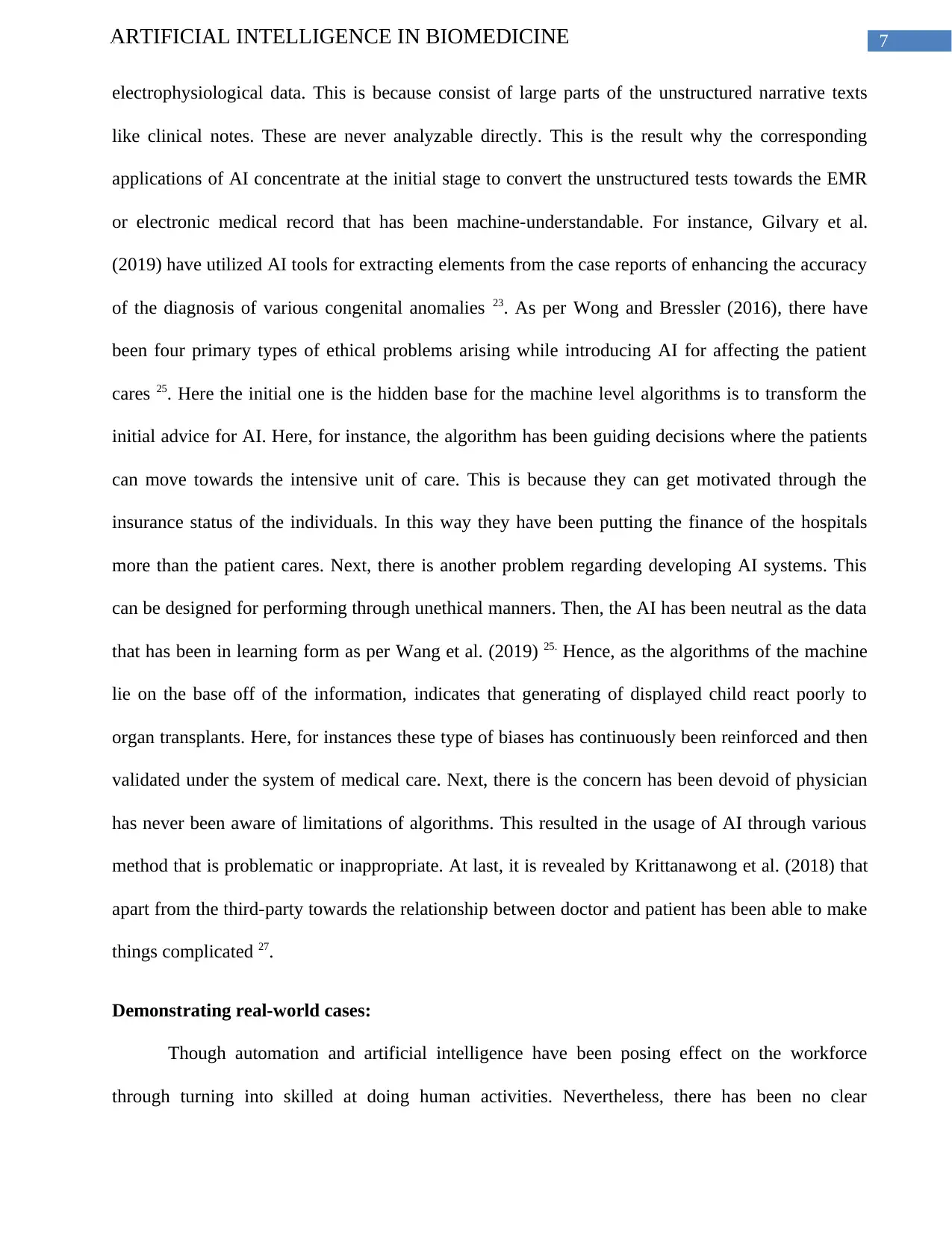
7ARTIFICIAL INTELLIGENCE IN BIOMEDICINE
electrophysiological data. This is because consist of large parts of the unstructured narrative texts
like clinical notes. These are never analyzable directly. This is the result why the corresponding
applications of AI concentrate at the initial stage to convert the unstructured tests towards the EMR
or electronic medical record that has been machine-understandable. For instance, Gilvary et al.
(2019) have utilized AI tools for extracting elements from the case reports of enhancing the accuracy
of the diagnosis of various congenital anomalies 23. As per Wong and Bressler (2016), there have
been four primary types of ethical problems arising while introducing AI for affecting the patient
cares 25. Here the initial one is the hidden base for the machine level algorithms is to transform the
initial advice for AI. Here, for instance, the algorithm has been guiding decisions where the patients
can move towards the intensive unit of care. This is because they can get motivated through the
insurance status of the individuals. In this way they have been putting the finance of the hospitals
more than the patient cares. Next, there is another problem regarding developing AI systems. This
can be designed for performing through unethical manners. Then, the AI has been neutral as the data
that has been in learning form as per Wang et al. (2019) 25. Hence, as the algorithms of the machine
lie on the base off of the information, indicates that generating of displayed child react poorly to
organ transplants. Here, for instances these type of biases has continuously been reinforced and then
validated under the system of medical care. Next, there is the concern has been devoid of physician
has never been aware of limitations of algorithms. This resulted in the usage of AI through various
method that is problematic or inappropriate. At last, it is revealed by Krittanawong et al. (2018) that
apart from the third-party towards the relationship between doctor and patient has been able to make
things complicated 27.
Demonstrating real-world cases:
Though automation and artificial intelligence have been posing effect on the workforce
through turning into skilled at doing human activities. Nevertheless, there has been no clear
electrophysiological data. This is because consist of large parts of the unstructured narrative texts
like clinical notes. These are never analyzable directly. This is the result why the corresponding
applications of AI concentrate at the initial stage to convert the unstructured tests towards the EMR
or electronic medical record that has been machine-understandable. For instance, Gilvary et al.
(2019) have utilized AI tools for extracting elements from the case reports of enhancing the accuracy
of the diagnosis of various congenital anomalies 23. As per Wong and Bressler (2016), there have
been four primary types of ethical problems arising while introducing AI for affecting the patient
cares 25. Here the initial one is the hidden base for the machine level algorithms is to transform the
initial advice for AI. Here, for instance, the algorithm has been guiding decisions where the patients
can move towards the intensive unit of care. This is because they can get motivated through the
insurance status of the individuals. In this way they have been putting the finance of the hospitals
more than the patient cares. Next, there is another problem regarding developing AI systems. This
can be designed for performing through unethical manners. Then, the AI has been neutral as the data
that has been in learning form as per Wang et al. (2019) 25. Hence, as the algorithms of the machine
lie on the base off of the information, indicates that generating of displayed child react poorly to
organ transplants. Here, for instances these type of biases has continuously been reinforced and then
validated under the system of medical care. Next, there is the concern has been devoid of physician
has never been aware of limitations of algorithms. This resulted in the usage of AI through various
method that is problematic or inappropriate. At last, it is revealed by Krittanawong et al. (2018) that
apart from the third-party towards the relationship between doctor and patient has been able to make
things complicated 27.
Demonstrating real-world cases:
Though automation and artificial intelligence have been posing effect on the workforce
through turning into skilled at doing human activities. Nevertheless, there has been no clear
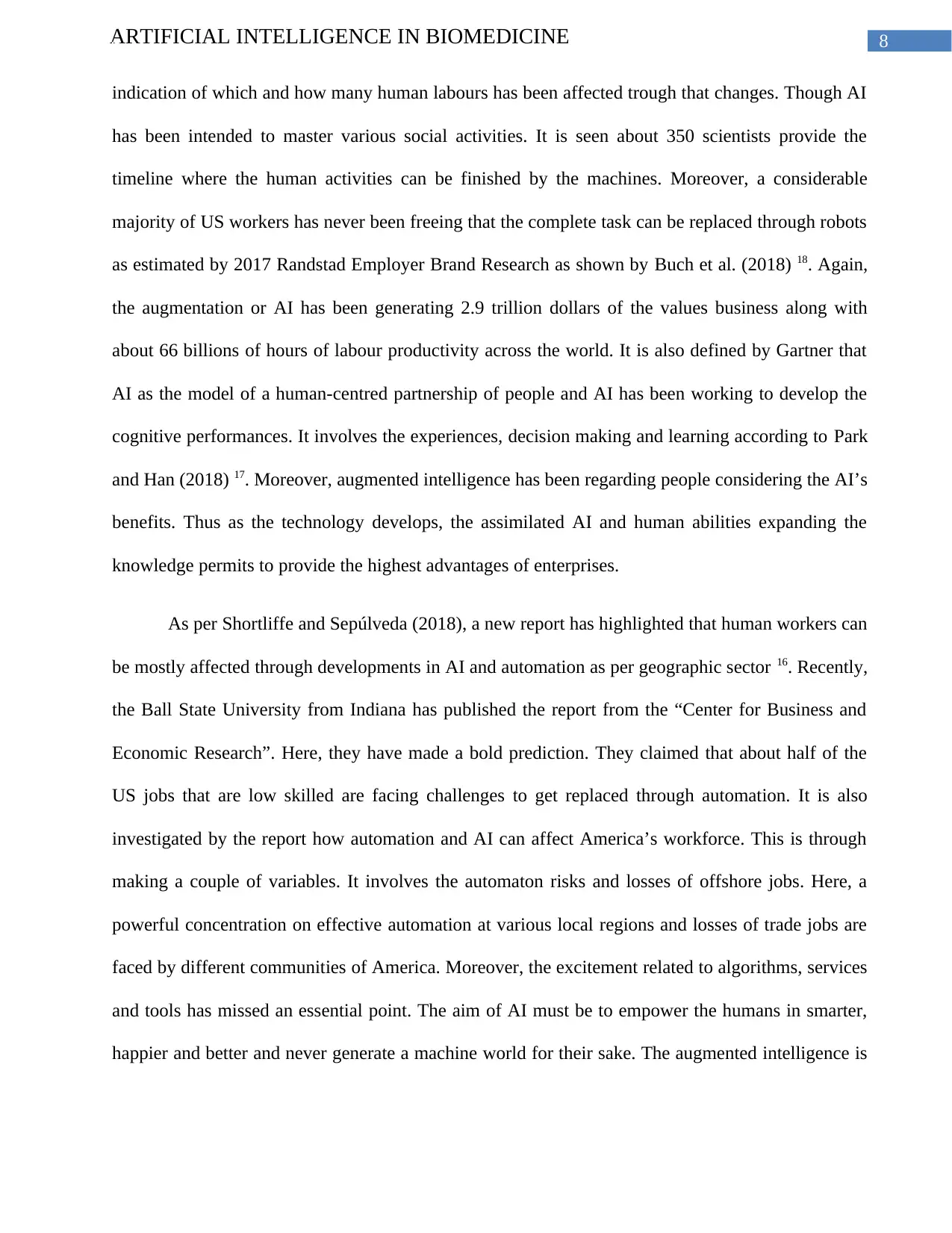
8ARTIFICIAL INTELLIGENCE IN BIOMEDICINE
indication of which and how many human labours has been affected trough that changes. Though AI
has been intended to master various social activities. It is seen about 350 scientists provide the
timeline where the human activities can be finished by the machines. Moreover, a considerable
majority of US workers has never been freeing that the complete task can be replaced through robots
as estimated by 2017 Randstad Employer Brand Research as shown by Buch et al. (2018) 18. Again,
the augmentation or AI has been generating 2.9 trillion dollars of the values business along with
about 66 billions of hours of labour productivity across the world. It is also defined by Gartner that
AI as the model of a human-centred partnership of people and AI has been working to develop the
cognitive performances. It involves the experiences, decision making and learning according to Park
and Han (2018) 17. Moreover, augmented intelligence has been regarding people considering the AI’s
benefits. Thus as the technology develops, the assimilated AI and human abilities expanding the
knowledge permits to provide the highest advantages of enterprises.
As per Shortliffe and Sepúlveda (2018), a new report has highlighted that human workers can
be mostly affected through developments in AI and automation as per geographic sector 16. Recently,
the Ball State University from Indiana has published the report from the “Center for Business and
Economic Research”. Here, they have made a bold prediction. They claimed that about half of the
US jobs that are low skilled are facing challenges to get replaced through automation. It is also
investigated by the report how automation and AI can affect America’s workforce. This is through
making a couple of variables. It involves the automaton risks and losses of offshore jobs. Here, a
powerful concentration on effective automation at various local regions and losses of trade jobs are
faced by different communities of America. Moreover, the excitement related to algorithms, services
and tools has missed an essential point. The aim of AI must be to empower the humans in smarter,
happier and better and never generate a machine world for their sake. The augmented intelligence is
indication of which and how many human labours has been affected trough that changes. Though AI
has been intended to master various social activities. It is seen about 350 scientists provide the
timeline where the human activities can be finished by the machines. Moreover, a considerable
majority of US workers has never been freeing that the complete task can be replaced through robots
as estimated by 2017 Randstad Employer Brand Research as shown by Buch et al. (2018) 18. Again,
the augmentation or AI has been generating 2.9 trillion dollars of the values business along with
about 66 billions of hours of labour productivity across the world. It is also defined by Gartner that
AI as the model of a human-centred partnership of people and AI has been working to develop the
cognitive performances. It involves the experiences, decision making and learning according to Park
and Han (2018) 17. Moreover, augmented intelligence has been regarding people considering the AI’s
benefits. Thus as the technology develops, the assimilated AI and human abilities expanding the
knowledge permits to provide the highest advantages of enterprises.
As per Shortliffe and Sepúlveda (2018), a new report has highlighted that human workers can
be mostly affected through developments in AI and automation as per geographic sector 16. Recently,
the Ball State University from Indiana has published the report from the “Center for Business and
Economic Research”. Here, they have made a bold prediction. They claimed that about half of the
US jobs that are low skilled are facing challenges to get replaced through automation. It is also
investigated by the report how automation and AI can affect America’s workforce. This is through
making a couple of variables. It involves the automaton risks and losses of offshore jobs. Here, a
powerful concentration on effective automation at various local regions and losses of trade jobs are
faced by different communities of America. Moreover, the excitement related to algorithms, services
and tools has missed an essential point. The aim of AI must be to empower the humans in smarter,
happier and better and never generate a machine world for their sake. The augmented intelligence is
⊘ This is a preview!⊘
Do you want full access?
Subscribe today to unlock all pages.

Trusted by 1+ million students worldwide
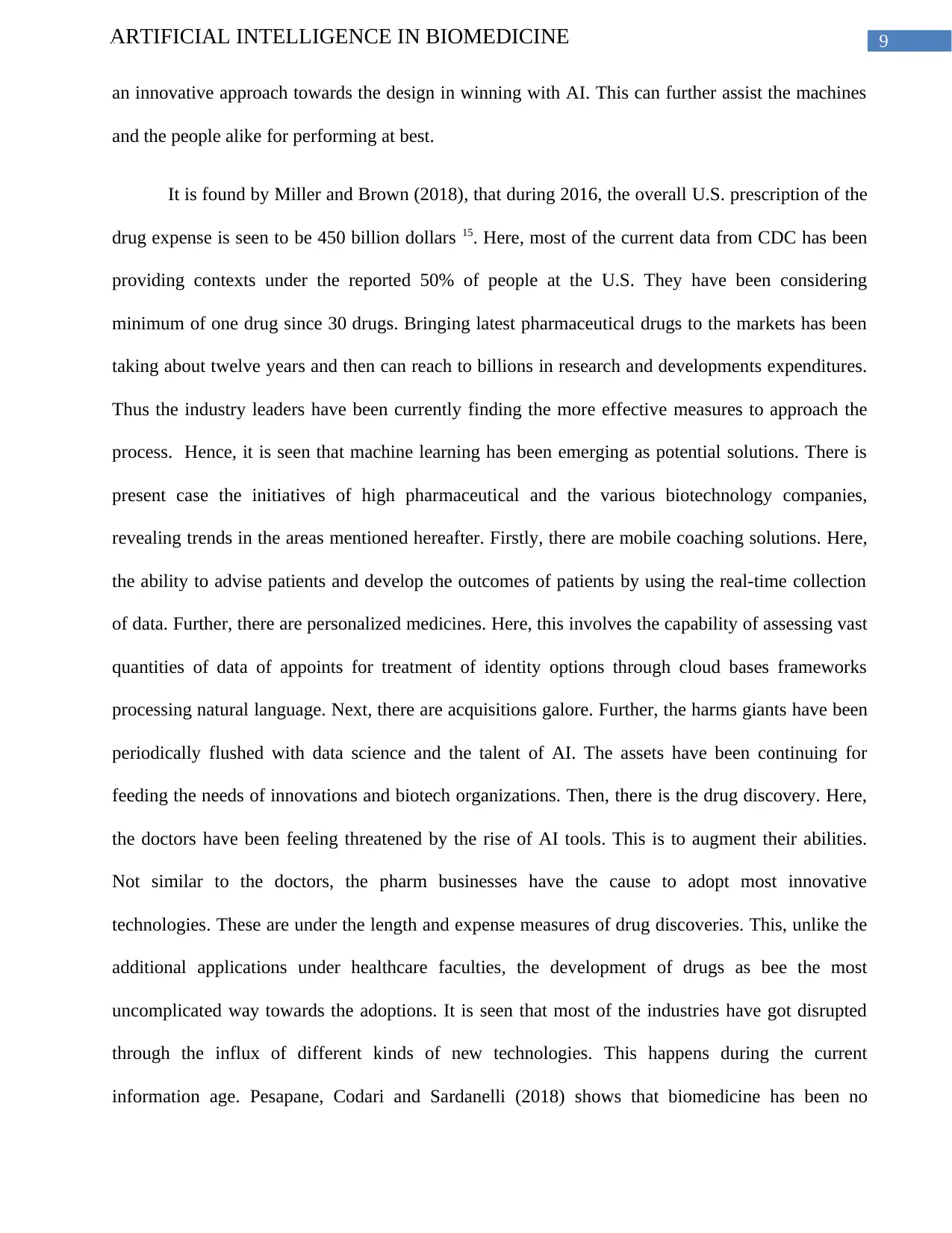
9ARTIFICIAL INTELLIGENCE IN BIOMEDICINE
an innovative approach towards the design in winning with AI. This can further assist the machines
and the people alike for performing at best.
It is found by Miller and Brown (2018), that during 2016, the overall U.S. prescription of the
drug expense is seen to be 450 billion dollars 15. Here, most of the current data from CDC has been
providing contexts under the reported 50% of people at the U.S. They have been considering
minimum of one drug since 30 drugs. Bringing latest pharmaceutical drugs to the markets has been
taking about twelve years and then can reach to billions in research and developments expenditures.
Thus the industry leaders have been currently finding the more effective measures to approach the
process. Hence, it is seen that machine learning has been emerging as potential solutions. There is
present case the initiatives of high pharmaceutical and the various biotechnology companies,
revealing trends in the areas mentioned hereafter. Firstly, there are mobile coaching solutions. Here,
the ability to advise patients and develop the outcomes of patients by using the real-time collection
of data. Further, there are personalized medicines. Here, this involves the capability of assessing vast
quantities of data of appoints for treatment of identity options through cloud bases frameworks
processing natural language. Next, there are acquisitions galore. Further, the harms giants have been
periodically flushed with data science and the talent of AI. The assets have been continuing for
feeding the needs of innovations and biotech organizations. Then, there is the drug discovery. Here,
the doctors have been feeling threatened by the rise of AI tools. This is to augment their abilities.
Not similar to the doctors, the pharm businesses have the cause to adopt most innovative
technologies. These are under the length and expense measures of drug discoveries. This, unlike the
additional applications under healthcare faculties, the development of drugs as bee the most
uncomplicated way towards the adoptions. It is seen that most of the industries have got disrupted
through the influx of different kinds of new technologies. This happens during the current
information age. Pesapane, Codari and Sardanelli (2018) shows that biomedicine has been no
an innovative approach towards the design in winning with AI. This can further assist the machines
and the people alike for performing at best.
It is found by Miller and Brown (2018), that during 2016, the overall U.S. prescription of the
drug expense is seen to be 450 billion dollars 15. Here, most of the current data from CDC has been
providing contexts under the reported 50% of people at the U.S. They have been considering
minimum of one drug since 30 drugs. Bringing latest pharmaceutical drugs to the markets has been
taking about twelve years and then can reach to billions in research and developments expenditures.
Thus the industry leaders have been currently finding the more effective measures to approach the
process. Hence, it is seen that machine learning has been emerging as potential solutions. There is
present case the initiatives of high pharmaceutical and the various biotechnology companies,
revealing trends in the areas mentioned hereafter. Firstly, there are mobile coaching solutions. Here,
the ability to advise patients and develop the outcomes of patients by using the real-time collection
of data. Further, there are personalized medicines. Here, this involves the capability of assessing vast
quantities of data of appoints for treatment of identity options through cloud bases frameworks
processing natural language. Next, there are acquisitions galore. Further, the harms giants have been
periodically flushed with data science and the talent of AI. The assets have been continuing for
feeding the needs of innovations and biotech organizations. Then, there is the drug discovery. Here,
the doctors have been feeling threatened by the rise of AI tools. This is to augment their abilities.
Not similar to the doctors, the pharm businesses have the cause to adopt most innovative
technologies. These are under the length and expense measures of drug discoveries. This, unlike the
additional applications under healthcare faculties, the development of drugs as bee the most
uncomplicated way towards the adoptions. It is seen that most of the industries have got disrupted
through the influx of different kinds of new technologies. This happens during the current
information age. Pesapane, Codari and Sardanelli (2018) shows that biomedicine has been no
Paraphrase This Document
Need a fresh take? Get an instant paraphrase of this document with our AI Paraphraser
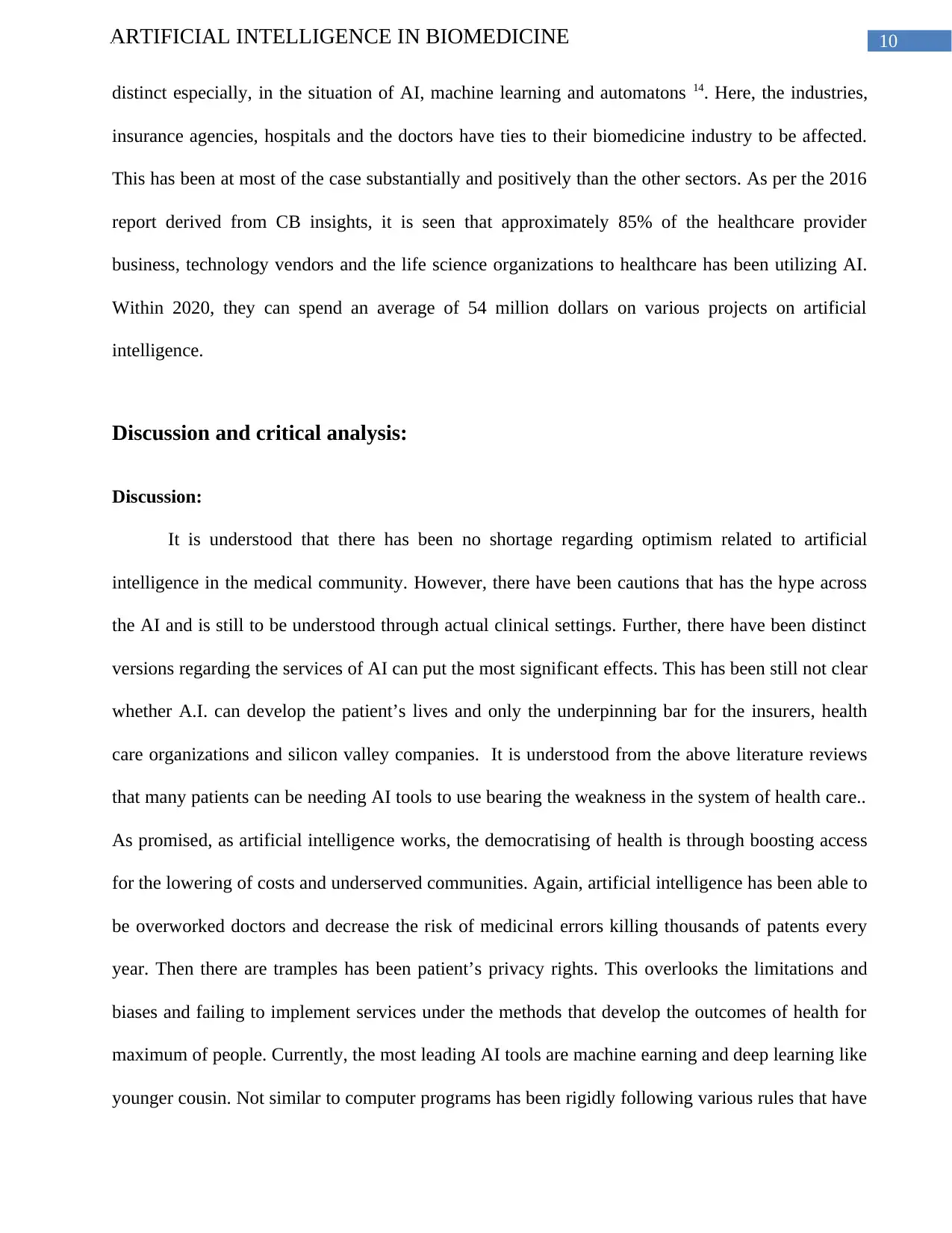
10ARTIFICIAL INTELLIGENCE IN BIOMEDICINE
distinct especially, in the situation of AI, machine learning and automatons 14. Here, the industries,
insurance agencies, hospitals and the doctors have ties to their biomedicine industry to be affected.
This has been at most of the case substantially and positively than the other sectors. As per the 2016
report derived from CB insights, it is seen that approximately 85% of the healthcare provider
business, technology vendors and the life science organizations to healthcare has been utilizing AI.
Within 2020, they can spend an average of 54 million dollars on various projects on artificial
intelligence.
Discussion and critical analysis:
Discussion:
It is understood that there has been no shortage regarding optimism related to artificial
intelligence in the medical community. However, there have been cautions that has the hype across
the AI and is still to be understood through actual clinical settings. Further, there have been distinct
versions regarding the services of AI can put the most significant effects. This has been still not clear
whether A.I. can develop the patient’s lives and only the underpinning bar for the insurers, health
care organizations and silicon valley companies. It is understood from the above literature reviews
that many patients can be needing AI tools to use bearing the weakness in the system of health care..
As promised, as artificial intelligence works, the democratising of health is through boosting access
for the lowering of costs and underserved communities. Again, artificial intelligence has been able to
be overworked doctors and decrease the risk of medicinal errors killing thousands of patents every
year. Then there are tramples has been patient’s privacy rights. This overlooks the limitations and
biases and failing to implement services under the methods that develop the outcomes of health for
maximum of people. Currently, the most leading AI tools are machine earning and deep learning like
younger cousin. Not similar to computer programs has been rigidly following various rules that have
distinct especially, in the situation of AI, machine learning and automatons 14. Here, the industries,
insurance agencies, hospitals and the doctors have ties to their biomedicine industry to be affected.
This has been at most of the case substantially and positively than the other sectors. As per the 2016
report derived from CB insights, it is seen that approximately 85% of the healthcare provider
business, technology vendors and the life science organizations to healthcare has been utilizing AI.
Within 2020, they can spend an average of 54 million dollars on various projects on artificial
intelligence.
Discussion and critical analysis:
Discussion:
It is understood that there has been no shortage regarding optimism related to artificial
intelligence in the medical community. However, there have been cautions that has the hype across
the AI and is still to be understood through actual clinical settings. Further, there have been distinct
versions regarding the services of AI can put the most significant effects. This has been still not clear
whether A.I. can develop the patient’s lives and only the underpinning bar for the insurers, health
care organizations and silicon valley companies. It is understood from the above literature reviews
that many patients can be needing AI tools to use bearing the weakness in the system of health care..
As promised, as artificial intelligence works, the democratising of health is through boosting access
for the lowering of costs and underserved communities. Again, artificial intelligence has been able to
be overworked doctors and decrease the risk of medicinal errors killing thousands of patents every
year. Then there are tramples has been patient’s privacy rights. This overlooks the limitations and
biases and failing to implement services under the methods that develop the outcomes of health for
maximum of people. Currently, the most leading AI tools are machine earning and deep learning like
younger cousin. Not similar to computer programs has been rigidly following various rules that have
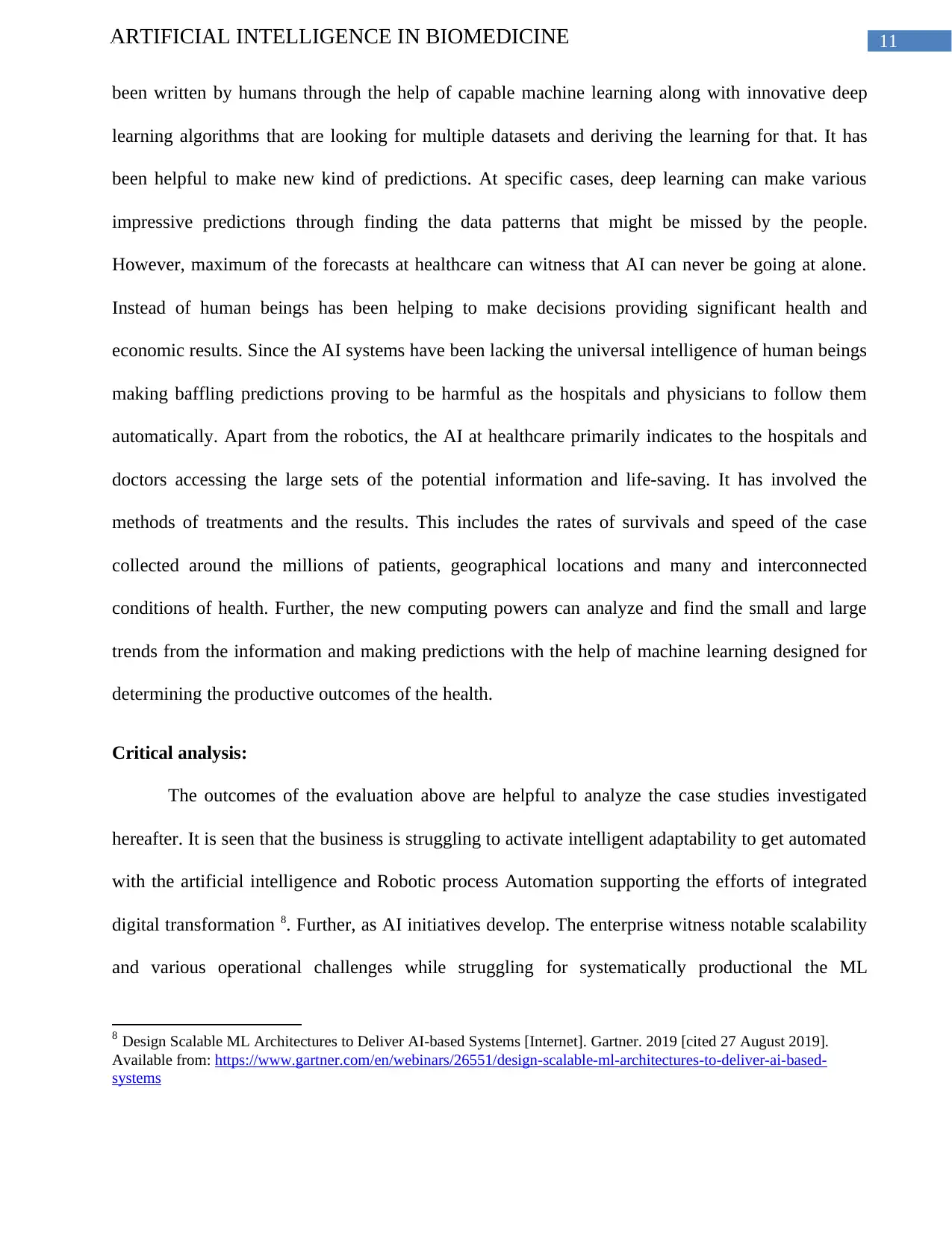
11ARTIFICIAL INTELLIGENCE IN BIOMEDICINE
been written by humans through the help of capable machine learning along with innovative deep
learning algorithms that are looking for multiple datasets and deriving the learning for that. It has
been helpful to make new kind of predictions. At specific cases, deep learning can make various
impressive predictions through finding the data patterns that might be missed by the people.
However, maximum of the forecasts at healthcare can witness that AI can never be going at alone.
Instead of human beings has been helping to make decisions providing significant health and
economic results. Since the AI systems have been lacking the universal intelligence of human beings
making baffling predictions proving to be harmful as the hospitals and physicians to follow them
automatically. Apart from the robotics, the AI at healthcare primarily indicates to the hospitals and
doctors accessing the large sets of the potential information and life-saving. It has involved the
methods of treatments and the results. This includes the rates of survivals and speed of the case
collected around the millions of patients, geographical locations and many and interconnected
conditions of health. Further, the new computing powers can analyze and find the small and large
trends from the information and making predictions with the help of machine learning designed for
determining the productive outcomes of the health.
Critical analysis:
The outcomes of the evaluation above are helpful to analyze the case studies investigated
hereafter. It is seen that the business is struggling to activate intelligent adaptability to get automated
with the artificial intelligence and Robotic process Automation supporting the efforts of integrated
digital transformation 8. Further, as AI initiatives develop. The enterprise witness notable scalability
and various operational challenges while struggling for systematically productional the ML
8 Design Scalable ML Architectures to Deliver AI-based Systems [Internet]. Gartner. 2019 [cited 27 August 2019].
Available from: https://www.gartner.com/en/webinars/26551/design-scalable-ml-architectures-to-deliver-ai-based-
systems
been written by humans through the help of capable machine learning along with innovative deep
learning algorithms that are looking for multiple datasets and deriving the learning for that. It has
been helpful to make new kind of predictions. At specific cases, deep learning can make various
impressive predictions through finding the data patterns that might be missed by the people.
However, maximum of the forecasts at healthcare can witness that AI can never be going at alone.
Instead of human beings has been helping to make decisions providing significant health and
economic results. Since the AI systems have been lacking the universal intelligence of human beings
making baffling predictions proving to be harmful as the hospitals and physicians to follow them
automatically. Apart from the robotics, the AI at healthcare primarily indicates to the hospitals and
doctors accessing the large sets of the potential information and life-saving. It has involved the
methods of treatments and the results. This includes the rates of survivals and speed of the case
collected around the millions of patients, geographical locations and many and interconnected
conditions of health. Further, the new computing powers can analyze and find the small and large
trends from the information and making predictions with the help of machine learning designed for
determining the productive outcomes of the health.
Critical analysis:
The outcomes of the evaluation above are helpful to analyze the case studies investigated
hereafter. It is seen that the business is struggling to activate intelligent adaptability to get automated
with the artificial intelligence and Robotic process Automation supporting the efforts of integrated
digital transformation 8. Further, as AI initiatives develop. The enterprise witness notable scalability
and various operational challenges while struggling for systematically productional the ML
8 Design Scalable ML Architectures to Deliver AI-based Systems [Internet]. Gartner. 2019 [cited 27 August 2019].
Available from: https://www.gartner.com/en/webinars/26551/design-scalable-ml-architectures-to-deliver-ai-based-
systems
⊘ This is a preview!⊘
Do you want full access?
Subscribe today to unlock all pages.

Trusted by 1+ million students worldwide
1 out of 16
Related Documents
Your All-in-One AI-Powered Toolkit for Academic Success.
+13062052269
info@desklib.com
Available 24*7 on WhatsApp / Email
![[object Object]](/_next/static/media/star-bottom.7253800d.svg)
Unlock your academic potential
Copyright © 2020–2025 A2Z Services. All Rights Reserved. Developed and managed by ZUCOL.





